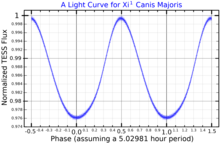| Observation data Epoch J2000.0 Equinox J2000.0 | |
|---|---|
| Constellation | Canis Major |
| Right ascension | 06h 31m 51.36636s[1] |
| Declination | −23° 25′ 06.3181″[1] |
| Apparent magnitude (V) | 4.33 – 4.36[2] |
| Characteristics | |
| Spectral type | B1 III[3] |
| U−B color index | −0.98[4] |
| B−V color index | −0.24[4] |
| Variable type | β Cep[3] |
| Astrometry | |
| Radial velocity (Rv) | +26.9[5] km/s |
| Proper motion (μ) | RA: −2.91[1] mas/yr Dec.: +6.22[1] mas/yr |
| Parallax (π) | 2.36 ± 0.20 mas[1] |
| Distance | 1,400 ± 100 ly (420 ± 40 pc) |
| Absolute magnitude (MV) | −3.86[6] |
| Details | |
| Mass | 14.2±0.4[6] M☉ |
| Radius | 7.9±0.6[6] R☉ |
| Luminosity | 30,900+8,900 −6,900[6] L☉ |
| Surface gravity (log g) | 3.78±0.07[6] cgs |
| Temperature | 27,000±1,000[6] K |
| Metallicity [Fe/H] | −0.18[7] dex |
| Rotational velocity (v sin i) | 0[6] km/s |
| Age | 11.1±0.7[6] Myr |
| Other designations | |
| Database references | |
| SIMBAD | data |
Xi1 Canis Majoris, Latinized from ξ1 Canis Majoris, is a Beta Cephei variable star in the constellation Canis Major. It is approximately 1,400 light years from Earth.
ξ1 Canis Majoris is a blue-white B-type star. It has generally been assigned a luminosity class of III (giant) or IV (subgiant), for example B1III[3] or B0.5IV.[6] Comparison of its properties with model evolutionary tracks suggest that it is a main sequence star about three quarters of the way through its main sequence lifetime.[6]

The apparent magnitude varies from +4.33 to +4.36 with a period of 5.03 hours.[2] Its pulsations cause its radius to vary by 1.0% to 1.5%. At the same time its effective temperature by about 500 K above and below its mean temperature.[6]
ξ1 Canis Majoris has the longest known rotation period of any B class star, taking around 30 years to complete one revolution on its axis.[9] This is thought to be due to magnetic braking; ξ1 Canis Majoris has the strongest magnetic field of any β Cephei star and would be expected to spin down completely in around four million years. It also has the strongest and hardest X-ray emission of any β Cephei star.[6]
ξ1 Canis Majoris forms a naked eye pairing with ξ2 Canis Majoris a little less than a degree away. The Washington Double Star Catalog lists two 14th magnitude companions about 27″ away.[10] In addition, an unseen close companion is suspected due to some faint emission lines in the spectrum that are best explained by a Be star invisible against the brighter primary.[6]
- ^ a b c d e Cite error: The named reference
vanLeeuwen2007was invoked but never defined (see the help page). - ^ a b Cite error: The named reference
vsxwas invoked but never defined (see the help page). - ^ a b c Cite error: The named reference
an330_4_317was invoked but never defined (see the help page). - ^ a b Cite error: The named reference
Johnson1966was invoked but never defined (see the help page). - ^ Cite error: The named reference
rgcrvwas invoked but never defined (see the help page). - ^ a b c d e f g h i j k l m Cite error: The named reference
schultz2017was invoked but never defined (see the help page). - ^ Cite error: The named reference
Anderson2012was invoked but never defined (see the help page). - ^ Cite error: The named reference
MASTwas invoked but never defined (see the help page). - ^ Cite error: The named reference
schultz2018was invoked but never defined (see the help page). - ^ Cite error: The named reference
wdswas invoked but never defined (see the help page).
